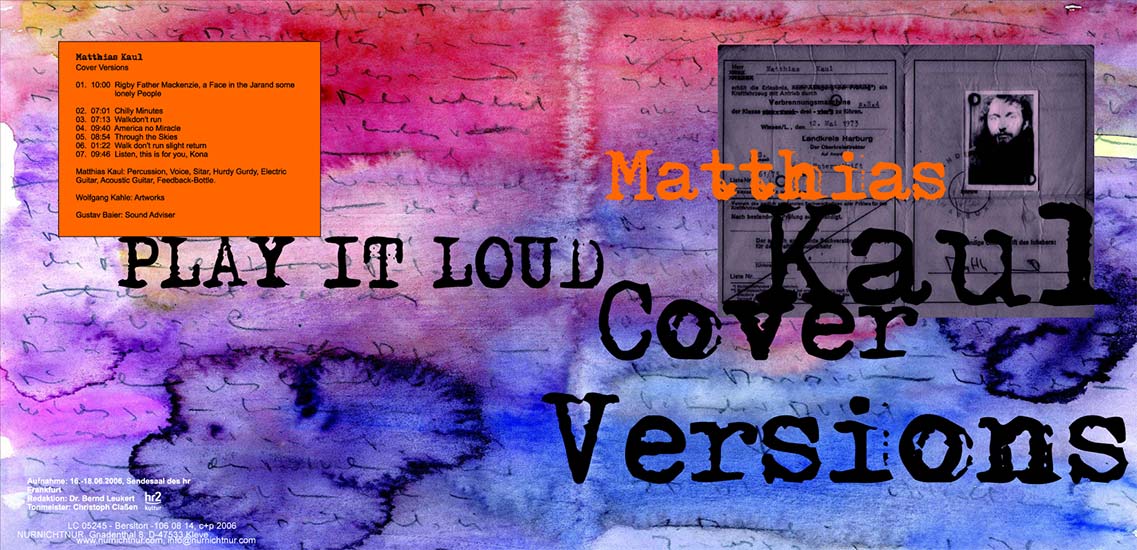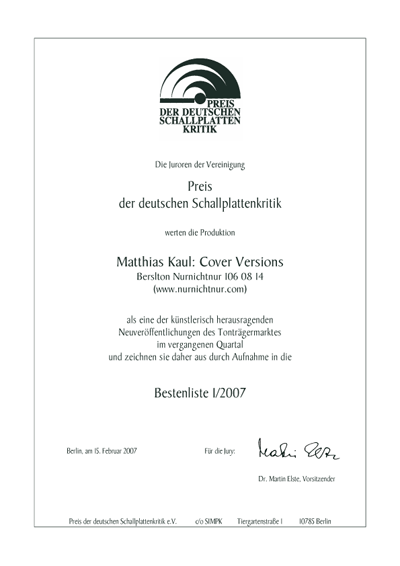
Matthias Kaul – Cover VersionsRigby, Father Mackenzie, a Face in the Jar and some lonely People. (2005) Chilly winds ( 2005) Walk Don’t Run ( 2005) America no Miracle (2005) Through the Skies ( 2005) Walk Don’t Run slight return ( 2005) Listen this is for You, Kona ( 2004) |
The Eternity of RockWhen records still had two sides, the eternity of rock just lasted for half an hour: until you had to turn the record.
This had pros and cons. One disadvantage was that rock's virulent desire for dramatic musical dimensions in consciously
composed concept albums, especially in the so-called progressive rock of the 1970s, experienced a dramaturgically abrupt
caesura. Even in rock, there was actually a discussion about the social and historical state of the musical material.
The appraisal of who you had just been dealing with in your private sphere often followed a simple pattern: tell me what
you listen to and I'll tell you who you are. |
The multi-instrumental drummer, Matthias Kaul, has created an acoustic monument of the third or fourth degree of elective affinity in honour of such subjective, deep-seated biographical incipits of rock and pop music from the corner store that used to be our record shelf. His cover versions testify both a love and hate of the originals, as well as the inability to forget all those things that should long ago have disappeared into the Orcus of those 9/10 of our brains that lie idle. Kaul tells us about the junk, the wacky, but also about the simply beautiful things in rock and pop music in a rather enervating and instant way – but in a way as if the record player was not earthed and as if the finger-acrobatic promises of Alvin Lee's furious Woodstock guitar solo in "Going home" would never again come through the vibrating speaker membrane in order to make you shake your head until you are dizzy while sitting on your neighbour's lounge chair when nobody is home. With Kaul, the originals or reference pieces are just merely rudimentary and vaguely identifiable originals shine through a sound veil made up of the very finely adjusted noise and intonation repertory of his percussion instruments. This method guarantees him an intense evocation of impressions of distance, for example in the cover version of "Through the Skies", a piece on the music of Jimi Hendrix combined with the madrigal art of Claudio Monteverdi. The voices of Monteverdi arise from the multiple broken sound cosmos of an electric guitar with distortion and reverb, as if Judgement Day has come. Coffins open with a creak and a crack, and brasses are shifted aside from within. Kaul uses an overmodulation of the acoustic signals to accentuate the very atonal moment in rock music that is inherent in any sound distortion – ever since "I can't get no satisfaction" by the Rolling Stones, the first song ever in which the sound of the guitar was distorted. In this rather noisy context, in which Kaul even refers to the solitude of airports, it no longer stands out that you don't even have to strike those legendary three chords any more if you wish to flirt with the charm of a basement band. Through his confrontation of the old multi-choir quality from San Marco in Venice with Jimi Hendrix, who has long since been beatified by his fans, Kaul himself immediately breaks open the Trinity of a tonic-dominant-tonic pattern with his self-invented feedback instrument made of empty bottles and erasing movements on the drum skin or the cymbals. All that remains is the naked aura of rock, an anticipation of rebellion and self-assertion.If Adorno's congruency of form and content that was once introduced as a quality seal still endures in music today, then it does so in Kaul's odd sounding cover versions. These are so alienated that they are reduced to monadic pixels of their former aura and they search for their neural channels themselves. But they do this in such a bloated way and so swivelled, turned and archaised under Kaul's intonational micros-cope that the recipient ends up asking himself whether this record could also be played without electricity. Kaul actually demonstrates once again that he can build a monumental sound cosmos of sinus-loving frequency channels with traditional instrument and some objéts trouvés, a sound cosmos where there would still be space for even the entire history of electronic music. His little universe expands further, and within it, Kaul works undercover as a child in time. That is the eternity of rock. Achim Heidenreich |
 |
"Cover Versions"'Cover version' was a well-known term in 1960s pop culture. Seemingly self-determined artistic individuals who wrote their own songs gradually took the place of mere interpreters and impersonators à la Elvis. The launch pad for almost all of these was rhythm'n'blues; a lively and enticing style that owed much to its African roots. Being steeped in this African tradition meant that it spread with a kind of 'ripple effect', moving from region to region, from player to player, becoming accessible to everyone. From a romantically transfigured Western point of view, it was a utopian artistic ideal that suited the diffuse need for freedom in the counter-culture that had just developed at the time. "But what can a poor boy do"- within the great scheme of a pop industry intent on maximising profit, the largest possible obtainable freedom is the ownership of literary property: the protest singer as his own originator and, three decades later, as the supplier of advertising slogans ("The times they are a Changin'") or the musical discovery tour of two band mates as a world-leading trademark (Lennon/McCartney, Jagger/Richards). Cover versions were something of a relic from the R&B tradition. Songs were taken to new heights by different interpreters: Joe Cocker turned harmless sounding original Beatles versions into dramatic soul songs, while the Byrds used Californian sweetness to catapult Dylan onto the radio, despite the songs having far too many strophes to fit the usual pop formats. A few years ago, Johnny Cash went in the opposite direction: an elderly man revises songs by bands of the same generation of his children or grandchildren, sings them accompanied by just his guitar and delights all generations in equal measure. Matthias Kaul's "Coverversions" have nothing in common with these or any other classification attempts. No melodies, harmonies or beats reveal the originals. The titles serve as aids to understanding, just like the titles of the seven pieces. Some elements of 1960s/1970s pop are found here but in a completely different context: some originally rather negligible details of arrangements, figures or situations from song lyrics, effects, and the repeated crackle of a vinyl single that was played time and time again. This crackle is an introductory noise that leads you directly to Rigby, Father Mackenzie, a Face in the Jar and some lonely People. Yes, the Eleanor Rigby who earned the Beatles goodwill even amongst highbrow music aficionados, mainly because of the romantic to sad sounding strings. Their staccato is replaced here by a needle holder from a dentist's surgery that sounds very similar to a ticking clock. What the Beatles' strings romanticised is completely open now – you can listen to the people going about their activities: Eleanor Rigby picks up the rice and the church bell is also rung. Whenever the energising ticking disappears, the activity seems particularly bleak, as if nobody can stop of their own free will in this climate of hospitalism. The sitar that starts playing at some point and the doleful hurdy-gurdy solo – they do not consider clichés and instead place themselves in the very foreground without keeping any distance – Rock'n Roll! |
Towards the end, deep bass drums take you one level down to where the "Face in the Jar" is standing. You can actually see the apathetic bleating face right in front of you. Chilly winds refers to Donovan's "Catch The Wind" and Matthias Kaul's version almost seems like a reverse of its flower power innocence. Donovan's rather secondary, trailed away strings are an apt motivation for the metallic beats that determine the wind direction. The extended means, such as the accompanying guitar solo (with down-tuned strings, finger tapping, etc.) turn the presumably unwanted background noise of Donovan's guitar into the actual event. With the crackle of his old, often played single in the background, Matthias Kaul plays a snare drum solo and thus acoustically steps into the place where the enthusiasm for playing the drums was inspired in him in the past. You can hear how much the way he has chosen to go since then has led him into musical freedom: different passages of the drum skin, changing of the pitch or dealing with coincidences – all this plays a role in M. Kaul's very own way of playing the drums – a laid back style despite that always stays calm despite all choppiness – walk don't run! The smooth, searching tone at the beginning of America no Miracle is a reference to the typical 1980s synthesiser sound
from Bowie's "This is not America". Wood and fruit rattle sounds can interrupt it briefly, but they cannot
stop it. Resistant like glass fibre, it gains more and more power until a sitar played backwards starts to dance on top
of it - "Flower Power California". Modified by a talk box (of the kind disco-goers from the 1970s will remember
Peter Frampton using -"Do you feel alright?"), you can hear the names of more than 50 Indian tribes from California
at the end. They did not have anything to do with "California Dreaming" as they all had been eradicated long
before. Goetz Steeger |
Musik Fang den Wind mit dem Schlagzeug Bei einem Mann, der Stücke für einen "badenden Schlagzeuger" oder eine "Pyropoetische Musik" für Ensemble und Feuerwerk schreibt, muss man auf alles gefasst sein. Hamburg hpe |